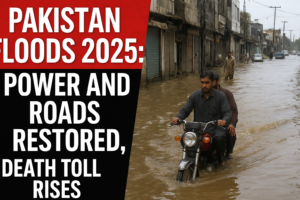
1. What Happened
Pakistan has been struck by catastrophic monsoon floods and cloudbursts, devastating both the north and south. More than 300 lives have been lost, with dozens still missing. The worst-hit district is Buner in Khyber Pakhtunkhwa (KP), where sudden cloudbursts swept away entire villages. Karachi, too, faced severe urban flooding, paralyzing daily life.
2. Restoration of Power and Roads
Officials confirm that 70% of the national electricity supply has been restored. Roads in northern and northwestern Pakistan have reopened, allowing rescue convoys and aid trucks to access previously cut-off communities. In Karachi, drainage operations are underway to clear submerged streets.
3. Relief Efforts
Military helicopters and relief agencies are distributing food, clean water, and medical assistance. Temporary shelters have been set up in KP, while the National Disaster Management Authority (NDMA) is coordinating relief efforts to ensure swift delivery of essentials.
4. Human and Economic Impact
Thousands of homes have collapsed, shops have been destroyed, and farmlands washed away. Daily wage earners and farmers face long-term financial hardships. Rising cases of waterborne diseases are adding to the crisis, making clean drinking water a top priority.
5. What’s Next
Authorities warn of further landslides and flash floods if monsoon rains persist. Damage assessments are ongoing to unlock reconstruction funds. Aid organizations emphasize cash support and resilient rebuilding to help affected families recover sustainably.